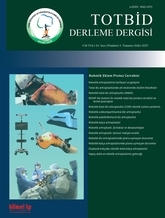
Since the introduction of total hip arthroplasty, rapid advancements have occurred in hip arthroplasty surgery, as in many other fields, such as developments in software, hardware, and metallurgy. Thanks to these advancements, orthopedic and traumatology specialists involved in hip arthroplasty have begun performing robotic hip arthroplasty using software and equipment during preoperative planning and surgical procedures. By supporting the entire arthroplasty process by including preoperative planning and with software and hardware, success rates have increased in areas such as implant placement, bone tissue resection, and postoperative satisfaction. Despite these advantages, unexpected situations those do not comply with the surgical plan can occur during robotic hip arthroplasty. Recognizing these problems and their solution is crucial. These problems may arise from software and/ or mechanical issues related to the robot, as well as problems with specialized instruments used in robotic surgery. If solutions to these issues are not found, the surgery may need to continue manually instead of robotically.